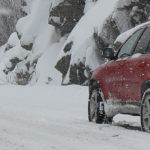Advanced hardware and software make Mazda’s i-ACTIV AWD system one of the smartest on the road
Mazda’s i-ACTIV All Wheel Drive (AWD) system launched a few years back when the CX-5 crossover hit the marketplace, and it’s available now in the CX-3 compact crossover, and the just-launched CX-9 as well.
Though this all-new, next-generation AWD system launched quietly and with little fanfare a few years back, it’s one of the most advanced, fast-acting and intelligent AWD systems on the road today.
Here’s a look at some neat facts about how the Mazda i-ACTIV AWD system gives shoppers enhanced handling, traction, confidence and fuel economy.
200 Times Per Second
In a single second, the computer controlling the i-ACTIV AWD system monitors inputs from a wide range of sensors some 200 times. The system checks on throttle and brake pressure, steering angles, vehicle speed, and even whether or not the wipers are activated. It’s all about giving the system plenty of information upon which to make smarter decisions on how to maximize traction and handling.
Monitoring all of these inputs is only half of the story, and the i-ACTIV system is equipped with hardware that lets it act on the inputs, as fast as they come in.
At the core of one of the fastest-responding AWD systems on the road? The Power Coupler. In simple terms, this coffee-can sized cylinder full of clutches and electromagnets can clamp up, or release, its clutches– altering the amount of power sent to the rear axle as quickly as the current flowing through its electromagnets can be changed, which is to say, instantly. Just 4 amps locks the clutches, and therefore the front and rear axles together.
The really neat stuff? To compensate for minor variances in responsiveness of each power coupler because of the manufacturing process, each individual coupler is run through a barrage of diagnostic tests at the factory, and the results are programmed into the AWD system computer for absolute fine-tuning. It’s all part of creating an AWD system that can respond to inputs, 200 times per second.
More Ribs = More Efficient
The gears that spin around within an All Wheel Drive system need to be lubricated and cooled, so typically, they’re housed within a case that’s virtually filled with oil. The gears slosh around within, bathing themselves with oil as they spin.
The i-ACTIV AWD system takes a different approach. By doing some ‘detail work’ on the inside of the gear cases and casting ‘ribs’ into their inner surfaces, oil is trapped in close proximity to vital components, so less oil is needed. Clever oil-trapping surfaces within the i-ACTIV AWD gear case allow a drastic reduction in the amount of oil fill required—meaning lower system weight, and less energy, and fuel, required for the gears to churn within their bath of oil.
Mazda Engineering Manager Dave Coleman explains “the quantity of fluid needed is determined by how hot the fluid will get under extreme usage, and whether the bearings and gears will be lubricated under all conditions. A few well-placed ribs and barriers can deliver oil where it is needed, without requiring the whole assembly to be submerged”.
Numerous incremental improvements like this translate into fuel savings that drivers can see at the pumps.
Sneaky Slippage
A human driver can detect spinning or slipping wheels, but only once the wheels are accelerating while the vehicle isn’t. Turns out, according to Coleman and his team, that a tire generates maximum grip in certain situations with a fairly significant amount of slippage at play, though less than the driver is able to detect. So, in some situations, the i-ACTIV AWD system allows a generous but undetectable amount of slip to enhance handling and control.
Sensing through Steering
Advanced electric power steering plays a role in making the i-ACTIV AWD system even smarter. Since the steering system already monitors, very precisely, the level of steering angle, torque applied by the driver to the steering wheel, and individual wheel speeds, a huge stream of data is generated.
Coleman and his team found an interesting and unique way to use that data to make an even smarter AWD system.
He explains “by looking at how much steering torque is required to steer, we can directly measure the amount of available traction. The really beneficial part of this steering sensor is that we can measure traction even when we’re just coasting—a condition where most reactive AWD systems are blind. By using steering system sensors, even coasting downhill around a corner, the system can identify a sandy spot, or a puddle, or some ice, the instant the front tires hit it. Then, it couples the front and rear drivetrains to reduce the load on the front tires, before the rear tires even hit that same spot!”








